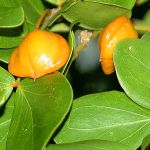| Common Name: |
Guaiacum |
| Other Names: |
Lignum Vitae, guaiac |
| Botanical Name: |
Guaiacum officinale |
| Genus: |
Guaiacum |
| Family: |
Zygophyllaceae |
| Native Location: |
Southern C America to northern S America, West Indies. |
| Cultivation: |
Rich, sandy, fibrous soil. Seedlings and saplings do not transplant well from small pots and should be given relatively large containers at each stage. |
| Propagation: |
By seed, sown with orange-yellow pericarp intact, when ripe at 26°C (79°F); by softwood cuttings in spring. |
| Harvest: |
Wood (preferably heartwood) is cut as required and processed into chips and shavings, which are heated to extract resin for use in decoctions, liquid extracts, and tinctures. |
| Height: |
5-9m (15-28ft) |
| Width: |
7-8m (22-25ft) |
| Hardiness: |
Z11 |
| Parts Used: |
Wood, resin. |
| Properties: |
A bitter, aromatic herb that stimulates the peripheral circulation, increases perspiration rate, is diuretic, anti-inflammatory, and expectorant, and clears toxins from the tissues. A mild laxative. |
| Medicinal Uses: |
Internally for upper respiratory tract infections. Internally and externally for rheumatic and arthritic complaints, and gout. Formerly used to treat syphilis. |
| Economic Uses: |
Resin is used to flavor baked products and chewing gum and is added to edible oils to improve keeping qualities. The wood is heavier than water ans is used in the propeller shafts of ships, as well as for bowling balls and carving. |
| Warning: |
This herb is subject to legal restrictions in some countries. |
| Bibliography: |
Encylopedia of Herbs by Deni Brown Copyright ©: 1995, 2001 Dorling Kindersley Limited pg. 229
|

